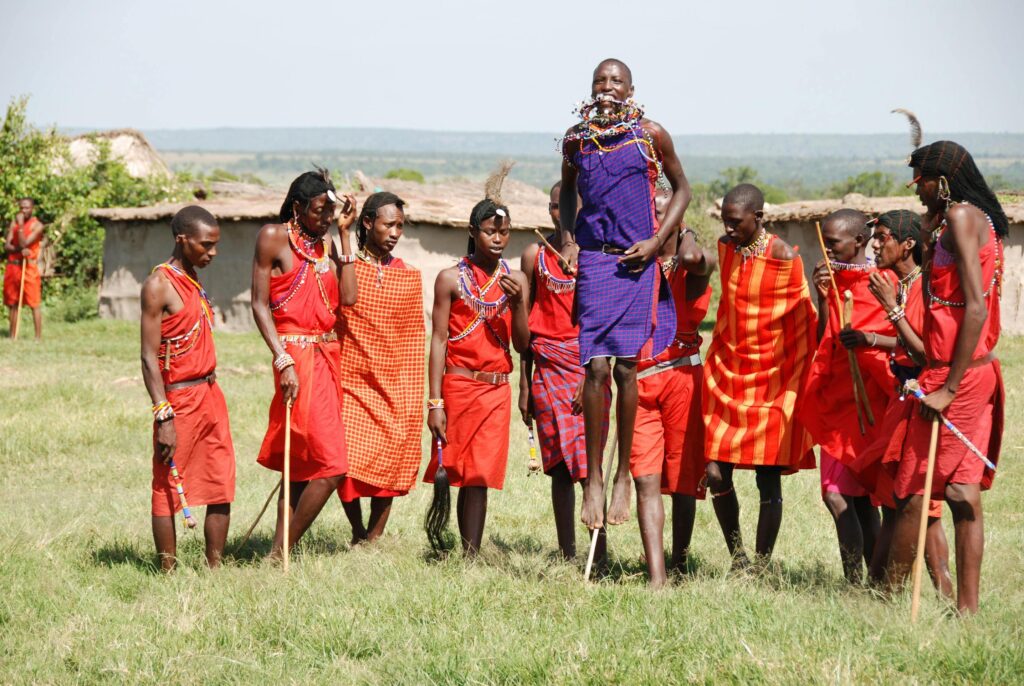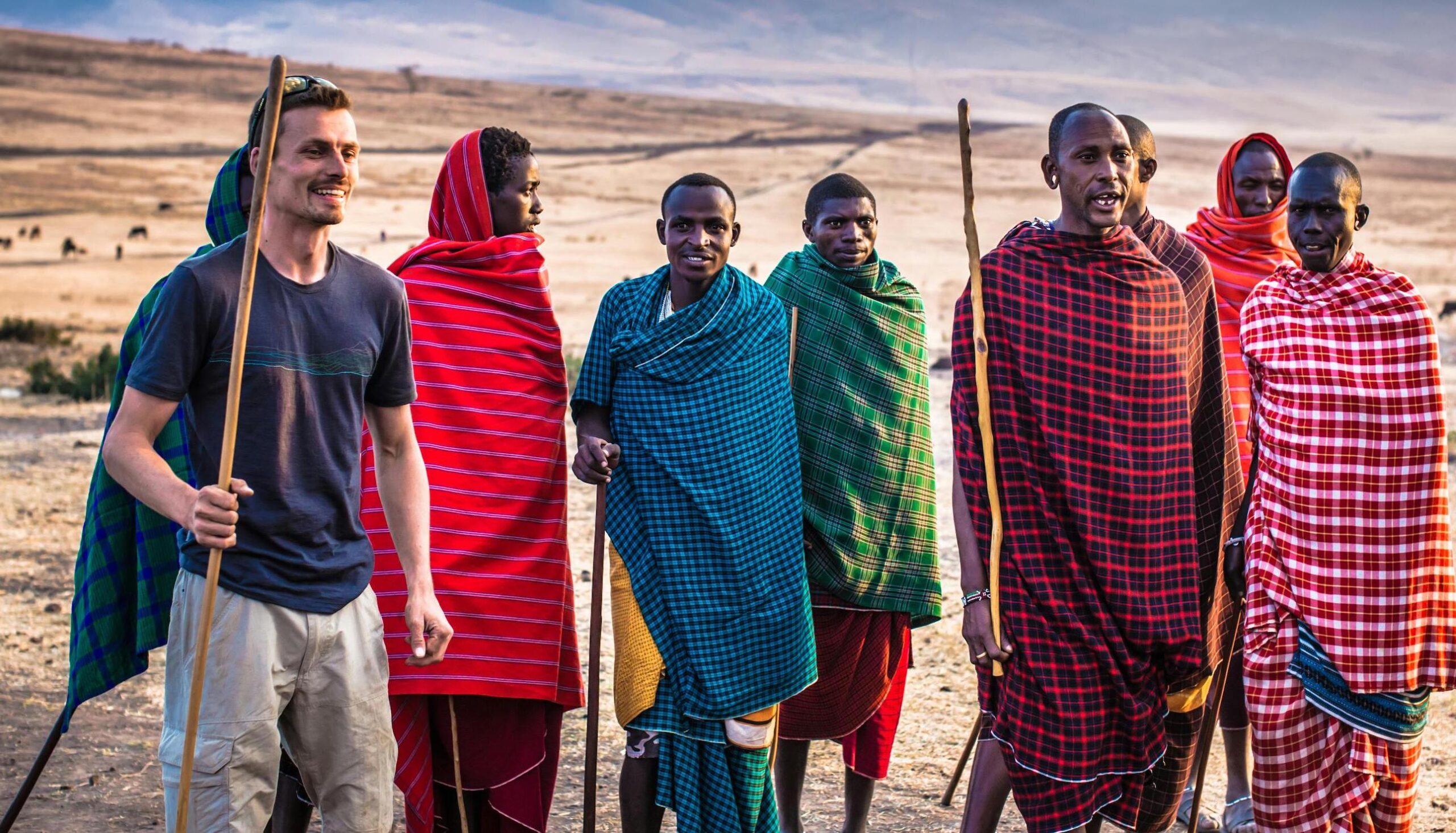Maasai Tribe
One of the famous tribes of Africa, the nomadic and pastoralist Maasai people are a Nilotic ethnic group inhabiting selected but large parts of northen Tanzania, northern, central and southern Kenya as well. The Maasai are in part the better known ethnic people in East Africa due to their traditional origins. The Maasai speak a language known as Maa. The Maasai have plenty of unique characteristics about their culture and some of these have been listed below, including their dress, diet and way of life.
Maasai Tribe Facts
Maasai Shelter: The Maasai tribe, historically a nomadic people, have traditionally relied on readily available materials and indigenous technology to construct their unusual and interesting housing. The traditional Maasai house was designed for people on the move and thus their houses were very impermanent in nature. The houses are either circular or loaf-shaped, and are made by women. Their villages are enveloped in a circular Enkang (fence) built by the men and this protects their cattle at night from wild animals.

Maasai Culture
Maasai society is firmly patriarchal in nature, with elder Maasai men sometimes joined by retired elders, determining most major matters for the Maasai tribes. For Maasai people living a traditional way of life, the end of life is virtually without a formal funeral ceremony, and the dead are left out in the fields for scavengers. Burial has in the past been reserved for great chiefs only, since it is believed by the Maasai that burial is harmful to the soil.
Traditional Maasai people’s lifestyle concentrates on their cattle which make up the primary source of food. Amongst the Maasai the measure of a man’s wealth is in terms of children and cattle. So the more the better. They believe that a man who has plenty of cattle but not many children is considered to be poor and vice versa. A Maasai myth says that God afforded them all the cattle on earth, resulting in the belief that rustling from other tribes is a matter of claiming what is rightfully theirs, a practice that has now become much less common.
Maasai Religion
The Maasai people are monotheistic, and their God is named Engai or Enkai, a God who is mostly benevolent and who manifests himself in the form of different colors, according to the feelings he is experiencing. Said colors have precise meanings: black and dark blue mean that the God is well-disposed towards men; red, on the other hand, is identified with God’s irritation.
Enkai has two manifestations:
Enkai-Narok, the Black God, good and beloved, brings grass and prosperity. He is found in thunder and rain.
Enkai-na-Nyokie, the Red God, vengeful, brings famine and hunger. He is found in lightning and is identified with the dry season.
The importance of cattle to the Maasai can be traced back to their religion and to Enkai. Today most of the Maasai people are christians and very few are muslims.
Maasai Diet
The traditional Maasai diet consists of six basic foods: meat, blood, milk, fat, honey, and tree bark. They drink both fresh and curdled milk. The fresh milk is drunk from calabash and sometimes it’s mixed with fresh cattle blood. The blood is obtained by nicking the jugular vein. Mixed blood and milk is mostly used as a ritual drink and as nourishment for the sick. Bulls, oxen and lambs are slaughtered for meat on special occasions and for ceremonies. The by-products of the animals – skin and hides are used as bedding while cow dung is used for building (it is smeared on the walls). The Maasai’s entire way of life truly revolves around their cattle. More recently, the Maasai people have supplemeted their diet with farm crops such as maize meal, rice, cabbage among other food crops.
Maasai Clothing
Clothing varies by sex, age and place. Young men wear black for several months after their circumcision. Although, red is a favored color among the Maasai. Black, Blue, checked and striped cloth are also worn, together with multi-coloured African garments. In the 1960s the Maasai began to replace sheepskin, calf hides and animal skin for more commercial material. The cloth used to wrap around the body is the called Shúkà in the Maa language.
The Maasai women regularly weave and bead jewellery, which plays an essential part in the ornamentation of their body. Ear piercing and the stretching of earlobes are also part of Maasaibeauty, and both men and women wear metal hoops on their stretched earlobes.
Maasai Hair
The maasai people, both women and men mostly shave their head to celebrate rites of passage such as circumcision and marriage. This represents the fresh start that will be made as one passes from one to another of life’s chapters. It’s only the Maasai warriors who are allowed to wear long hair, which they weave in thinly braided strands.
The maasai children are named upon reaching the age of 3 “moons” and their heads are shaved clean apart apart from a tuft of hair, which resembles a cockade, from the nape of the neck to the forehead. The young boys are also shaved two days before they are circumcised. The young warriors then allow their hair to grow, and spend a great deal of time styling the hair.
Maasai Music and Dance
The Maasai people don’t use instruments when they are singing or dancing. All of their music is vocal, except for the large horns used for certain songs. Their music comprises of rhythms rendered by a chorus of vocalists singing harmonies, all the while the olaranyani (song leader) sings the melody. The olaranyani is usually the person who can best sing that song. When olaranyani starts singing a line or title (namba) of a song, the group responds with one unanimous call in acknowledgment. The beads that both the men and women wear also create a jingling sound themselves while the Masai jump and dance. Women recite lullabies, hum songs and sing music that praises their sons.
The peak season for singing and dancing is during the rains, which is of course a favourable time to celebrate important passages of life such as circumcision and marriage. This mostly occur around the manyattas, and involve flirting.

MAASAI VILAGE TOUR.
Arguably the most iconic tribal group in all of Africa, the Maasai, who populate vast areas of northern areas of Tanzania are the dominant ethnic group surrounding the northern parks in Tanzania. This nomadic, warrior tribe which once held vast swathes of pre-colonial colonialism , still retain many of their traditions as they live largely untouched by modern day civilization, in areas surrounding Ngorongro and Manyara. So why visit a Maasai village and what do you get to see? This one hour visit to a Maasai village is a chance to interact with the Maasai and get a glimpse into their culture, unique way of life and see first hand some of their customs and practices.
The Maasai village visit is typically an excursion included into a longer multi day safari tour, and a couple of hours are set apart for this brief interactive visit to the village, which usually happens to be on the fringes of the main Mara game reserve boundaries. Many tourists wish to know how much it costs to visit a Maasai village. The price for a village visit which includes a contribution towards the village in form of a fee, as well as return road transfers from your lodge or camp to the village, varies between USD 15 to 40 per person. The price is often lower when you are on a road safari with your own Driver-Guide who will pay the fee upon entry. The higher fee of USD 40 per person often applies when you have flown in on a package safari and it is then the Camp which will charge you the fee for the village visit and the price in this case can vary again from USD 20 to USD 40 per person based on which camp you are staying at and which village they take you to visit. It should be noted that once at the village, you may be expected to buy some curio or souvenir from the villagers, though this is not mandatory having paid an entry fee. Nonetheless, be prepared for determined efforts from some of the Maasai villagers to try and sell you inexpensive handmade craft items. For some this can be an unpleasant part of the excursion though in totality we feel this is a minor negative that has become a part of the experience and the positive part of the visit outweighs the negative.
The Maasai are known for their many unique cultural practices and traditions. Some of these originate from their nomadic way of life.
So what is the name of a Maasai village ? Well, the Maasai live in structures known as ‘Manyatta’, which are low height dwellings, essentially huts, made of mud, cow dung and wood, with a single entrance and minimal side windows. Clusters of these manyatta huts, which form a homestead or village, are known as a Maasai ”Boma”. Several Bomas can also join together to make a larger village. The individual huts themselves, the manyattas, have windows so small that it can be very dark inside a manyatta even on a sunny day. The image above shows a typical Manyatta hut with a Maasai woman standing in front of the rear of the manyatta. The image below shows the inside of a Manyatta. In the photo you can see the earthen stove and firewood which will be used for cooking a meal. There is no piped water, electricity or Gas. We should point out that these specific manyattas or villages are right in the interior of Narok, close to the reserve. While there is power and piped water in the reserve itself and in the more developed part of Narok district, the very traditional Maasai villages still exist in this manner.
